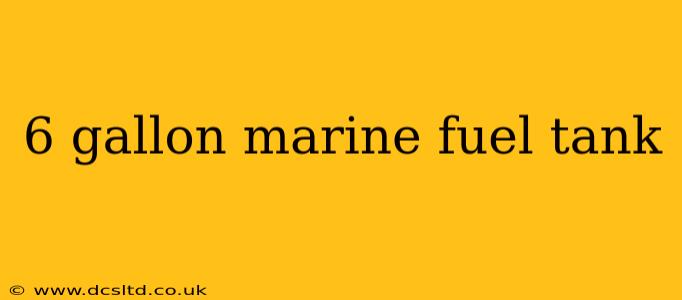Choosing the right fuel tank for your marine vessel is crucial for safety and performance. A 6-gallon marine fuel tank is a popular option for smaller boats, inflatables, and personal watercraft, offering a balance of capacity and portability. This guide will delve into the various aspects of selecting and using a 6-gallon marine fuel tank.
What are the Different Types of 6-Gallon Marine Fuel Tanks?
6-gallon marine fuel tanks are available in a variety of materials, each with its own advantages and disadvantages:
-
Plastic (Polyethylene): These are lightweight, relatively inexpensive, and resistant to corrosion. They are a popular choice for smaller boats due to their ease of handling and durability. However, they may not be as robust as metal tanks and can be susceptible to damage from impact.
-
Aluminum: Aluminum tanks are lightweight and strong, offering excellent resistance to corrosion. They are a good option for boats that require a more durable tank, but they are generally more expensive than plastic tanks.
-
Stainless Steel: Stainless steel tanks are the most durable and corrosion-resistant option, offering a long lifespan. They are heavier than plastic or aluminum tanks and are typically the most expensive.
What are the Key Features to Consider When Buying a 6-Gallon Marine Fuel Tank?
When choosing a 6-gallon marine fuel tank, consider these essential features:
-
Material: As discussed above, the material significantly impacts durability, weight, and cost.
-
Dimensions: Ensure the tank's dimensions fit the available space on your boat. Measure carefully before purchasing.
-
Mounting Brackets: Check if mounting brackets are included or need to be purchased separately. Secure mounting is vital for safety.
-
Fuel Level Gauge: A built-in fuel gauge provides convenient monitoring of fuel levels.
-
Vent: A properly functioning vent is crucial to prevent pressure buildup and ensure proper fuel flow.
-
Fill Spout: A wide-mouth fill spout simplifies refueling.
-
Certifications: Look for certifications like ABYC (American Boat and Yacht Council) to ensure the tank meets safety standards.
What are the Safety Precautions When Using a 6-Gallon Marine Fuel Tank?
Safety should always be the top priority when handling fuel. Follow these precautions:
-
Proper Ventilation: Ensure adequate ventilation in the area where you're handling or storing the fuel tank. Gasoline fumes are highly flammable.
-
Grounding: Use a grounding strap to prevent static electricity buildup, which can cause a spark and ignite fuel vapors.
-
Spill Containment: Have a spill kit readily available to clean up any accidental spills.
-
Storage: Store the fuel tank in a cool, dry, and well-ventilated place away from ignition sources when not in use.
-
Regular Inspection: Regularly inspect the tank for any signs of leaks, cracks, or damage.
How Long Does a 6-Gallon Marine Fuel Tank Last?
The lifespan of a 6-gallon marine fuel tank depends on the material, usage, and maintenance. A well-maintained plastic tank might last for several years, while a stainless steel tank can last for decades. Regular inspections and proper storage significantly extend the tank's lifespan.
How Much Does a 6-Gallon Marine Fuel Tank Cost?
The price of a 6-gallon marine fuel tank varies depending on the material, features, and brand. Expect to pay anywhere from a few tens to over a hundred dollars.
Where Can I Buy a 6-Gallon Marine Fuel Tank?
6-gallon marine fuel tanks are widely available from various retailers, including:
-
Marine supply stores: These stores offer a wide selection of tanks and related accessories.
-
Online retailers: Online platforms provide a broad range of options and price comparisons.
-
Boat dealers: Boat dealers often sell fuel tanks compatible with the boats they sell.
By carefully considering the factors discussed above, you can choose a 6-gallon marine fuel tank that meets your needs and ensures a safe and enjoyable boating experience. Remember that safety is paramount when handling gasoline, so always prioritize proper procedures and maintenance.
